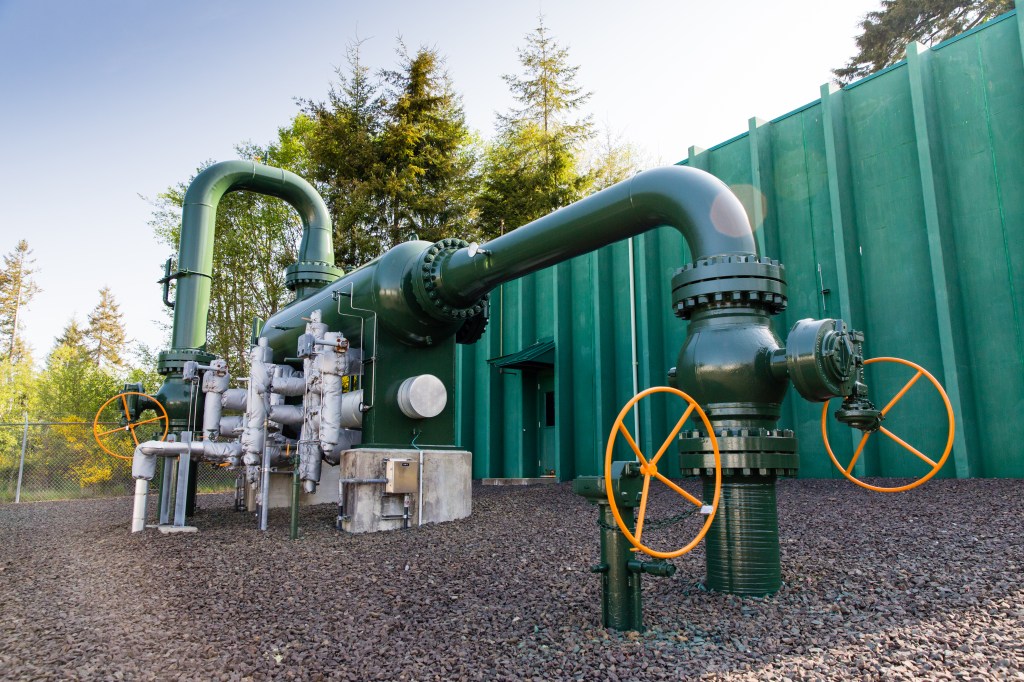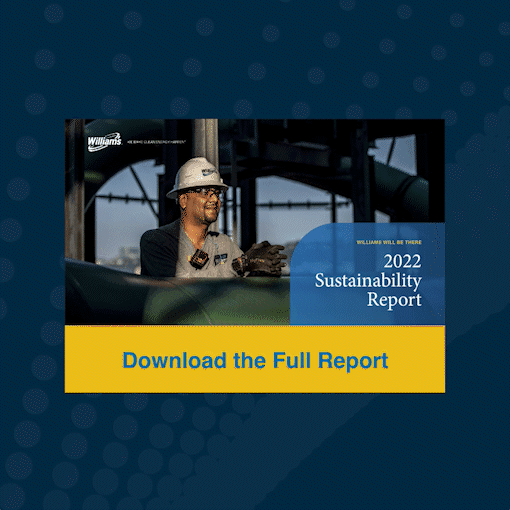Williams’ mission, to be the leader in providing infrastructure that safely delivers natural gas products to reliably fuel the clean energy economy, supports a strategic approach to evaluating climate related risks. As a part of the annual strategy process, Williams develops a variety of scenarios consisting of various market fundamentals including assumptions on political and social interventions to test plausible future outcomes for Williams. We compare our internally developed scenarios to third-party consultants’ energy transition scenarios. Results of the scenarios are provided to the board as a part of the annual strategy meeting. Strategic risks and opportunities, which could include climate-related risks, regarding the scenarios are included in the strategic discussions. In 2022, the strategy discussion with the board also included progress on emissions reduction in our core business and positive movement towards our climate commitment.
We understand that external stakeholders are interested in our climate-related practices and performance. To that end, Williams continues to align our climate change reporting with the recommendations established by the Financial Stability Board’s Task Force on Climate-related Financial Disclosures (TCFD). In 2021, we developed a TCFD index that maps our disclosures against the four TCFD thematic areas to increase transparency and help stakeholders easily identify relevant information.
CDP, another widely recognized disclosure and scoring process, issued Williams a ‘B’ score in 2022 for its commitment to transparency around climate change. This ranking exceeds the oil and gas storage and transportation activity group average of ‘C’ and the North American regional average of ‘C.’ Our score signifies that we incorporate effective governance practices and are taking coordinated action on climate change. 2023 will be our fourth consecutive year participating in CDP’s full disclosure and scoring process. For additional information on how Williams manages the risks and opportunities of climate change, see our response to the CDP climate change questionnaire.
Our commitment to mitigating climate change risk is reinforced by our public climate commitment, which was supported by our board of directors.

Physical Risks
We recognize that our business is subject to numerous types of physical risks. Our assets and operations, as well as our customers’ assets and operations, can be adversely affected by acute weather hazards such as flooding, hurricanes, wildfires and landslides, and chronic weather hazards such as extreme temperatures and drought. The magnitude of these physical risks may increase with the realization of worsening levels of warming. Extreme weather conditions may result in facility, pipeline or equipment damage or require more system backup, adding costs and increasing system stresses, including service interruptions.
The Williams Integrated Management System is one of the primary controls we have to mitigate physical risk. Through the platform, we are able to adhere to asset design standards that prioritize safety and operational reliability, mature integrity programs that maintain asset health and functionality, and safety procedures that keep people and equipment safe in the event of severe weather. Additionally, Williams’ business continuity planning and training include potential impacts from future acute and chronic weather hazards and help our employees appropriately respond when such challenges arise. As part of our operational process, we incorporate sufficient resiliency into our operations and systems based on historical weather patterns in our regions.
Transition Risks
Williams’ physical assets transport and process products that are critical inputs for electricity generation, heating and cooking in homes and businesses. In general, we view our assets as irreplaceable and vital to maintaining and improving quality of life by ensuring affordability and reliability of a low-carbon future. To that end, we integrate climate-related considerations into key capital expenditure planning, our annual strategy sessions and our strategic risk assessment processes.
Our operations are increasingly subject to environmental laws and regulations, many of which relate to climate change and GHG emissions. In addition to environmental laws and regulations, in 2022, several states adopted new net zero GHG emissions goals with interim targets, including those associated with Louisiana’s net zero by 2050 goal, Maryland’s net zero by 2040 goal and North Carolina’s net zero by 2050 goal. Similarly, states announced new regulations regarding climate and environmental justice considerations for permitting, including New York’s CP 49 and DAR 21 and Maryland’s HB 1200.
In 2022, the EPA published a proposed rule to reduce methane and other pollutants from oil and natural gas operations. The proposed rule, which is designed to mitigate GHG and volatile organic compound emissions from existing sources in the oil and natural gas industry, including transmission and storage facilities, could create a significant impact on how we operate. Additionally, the U.S. Securities and Exchange Commission has proposed a draft rule requiring the disclosure of climate-related information in broad alignment with the recommendations established by TCFD, with a final rule expected in 2023. We recognize that these new regulations and others may expose us to high costs, liabilities and expenditures above our expectations if we do not factor them into our current operational risk management strategy.
Williams uses a case-by-case analysis to determine option-specific costs to reduce our operational GHG emissions. Currently, we are operationalizing an internal cost of carbon on particularly scalable and actionable emissions sources and work practices with an eye towards external carbon market values. Operationalization of a cost of carbon method will be aligned with company objectives and will aim to progress Williams toward our climate commitment before a potential regulatory risk is actualized. Detailed studies are very important regarding actually reducing GHG emissions around our assets. As an example, this past year we studied the growing risk of our interdependence with the electrical power grid. We determined that in certain areas, utilizing electric driven compression equipment could reduce grid reliability and natural gas pipeline reliability while actually increasing our combined Scope 1 and Scope 2 emissions.
We continue to monitor legislative and regulatory developments related to climate change and voluntarily pursue efforts to reduce GHG emissions from our facilities. Using the Regional Greenhouse Gas Initiative’s actual weighted average price of $13.46 per metric ton of CO2 e in 2022, the gross expense to offset Williams’ 2022 Scope 1 emissions would be $179.4 million, which could be partially mitigated through customer agreements.[1] This mindset of mitigating risks in a way that delivers long-term value to shareholders also drives our integration of cleaner energies and technologies, which will help mitigate climate change regulation risk.
We have also faced opposition regarding the risks associated with operating and expanding our pipelines and facilities from some elected officials, environmental groups, landowners, tribal groups, local groups and others. While natural gas is critical to the clean energy economy, we recognize that stakeholder opposition may affect our ability to maintain and expand our operations. For more information, see Stakeholder Relations.
For a complete list of Williams’ risk factors, including both physical and transition climate change-related risks, see our 2022 Annual Report.
[1] Clearing prices used to calculate weighted average price per metric ton of CO2 e sourced from The Regional Greenhouse Gas Initiative’s website.


